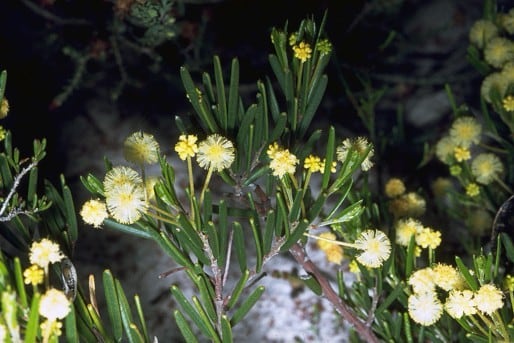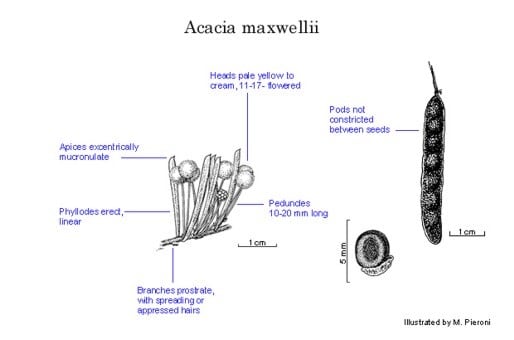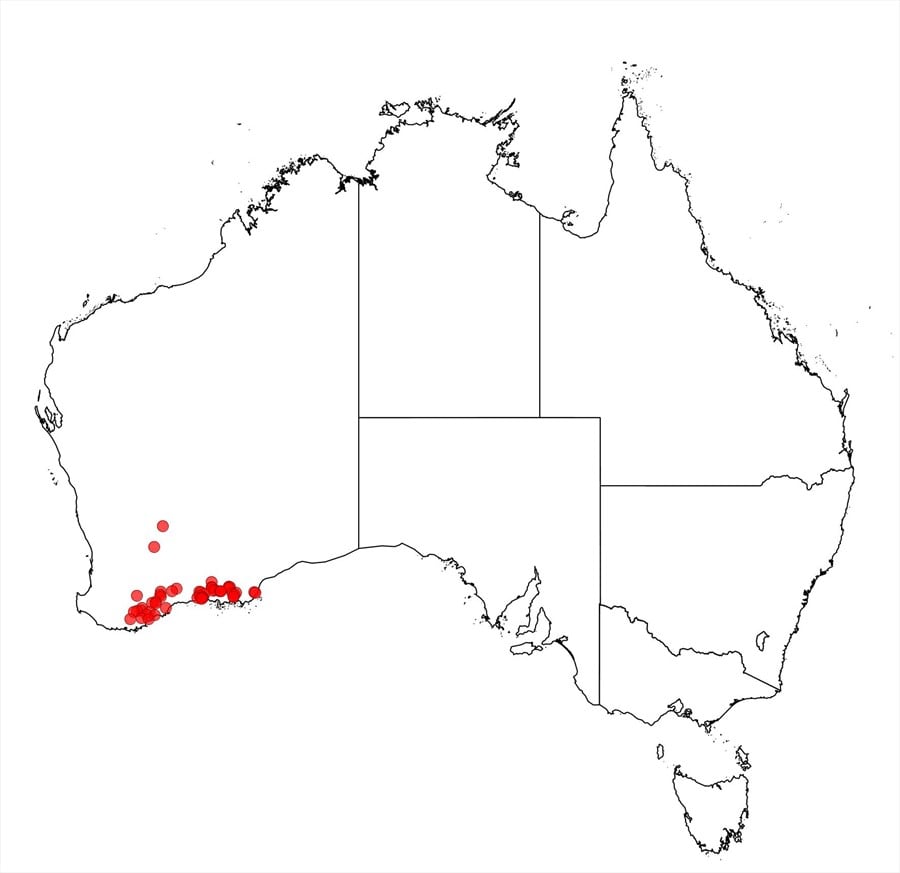Acacia maxwellii Maiden & Blakely
WATTLE
Acacias of Australia
Family
Fabaceae
Distribution
Extends from near the Stirling Ra. E to Israelite Bay, south-western W.A.
Description
Prostrate shrub, sometimes domed, to 0.4 m high. Branchlets puberulous with patent to appressed hairs. Stipules subpersistent, 1–2 mm long. Phyllodes erect, linear, rarely terete, straight to shallowly curved, 1.5–6 cm long, 1–3 mm wide, obtuse and excentrically mucronulate, occasionally acute, ±thick, rugose when dry, green, glabrous; midrib impressed when dry; gland 0.5–3.5 mm above pulvinus, sometimes absent. Inflorescences mostly 1–3-headed racemes; raceme axes 0.5–3 (–5) mm long, commonly growing out during anthesis; peduncles 1–2 cm long, glabrous to sparsely appressed-puberulous; heads globular, 5 mm diam., 11–17-flowered, pale yellow to cream. Flowers 5-merous, glabrous; sepals c. 3/4-united, with lobes broadly triangular. Pods linear, not constricted between seeds, to 4 cm long, 4–5 mm wide, crustaceous, dark brown, glabrous. Seeds longitudinal, broadly oblong-elliptic to circular, turgid, c. 3 mm long, dull, light brown; aril thick.
Habitat
Grows in sand, sandy loam, gravelly loam and clay, in shrub mallee and mallee heath, often along watercourses.
Specimens
W.A.: 1.6 km S of Jerramungup towards Albany, B.R.Maslin 2587 (PERTH); 12 km N of Israelite Bay on track to Balladonia, E.C.Nelson ANU16509 (PERTH); c. 3 km NE of Howick Hill, A.E.Orchard 1124 (MEL, PERTH).
Notes
The type locality has not been located on modern maps.
A variant with terete phyllodes, 15–30 mm long, is known from a single specimen collected from near Mt Heywood (K.Newbey 7952, PERTH: in very young fruit); the typical form of the species occurs nearby.
Also similar in general appearance to A. pachyphylla.
It is probable that the Baxter syntype of A. ramosissima is A. cupularis; apart from this specimen it is not known what others G.Bentham may have confounded with this name (see Bentham’s comment in Fl. Austral. 2: 360 (1864)).
Resembles superficially A. cupularis which usually has an erect habit, glabrous branchlets, phyllodes with a ±central mucro, much shorter peduncles and generally more flowers per head.
FOA Reference
Data derived from Flora of Australia Volumes 11A (2001), 11B (2001) and 12 (1998), products of ABRS, ©Commonwealth of Australia
Author
Minor edits by J.Rogers
B.R.Maslin
This identification key and fact sheets are available as a mobile application:
URL: https://apps.lucidcentral.org/wattle/
© Copyright 2018. All rights reserved.









